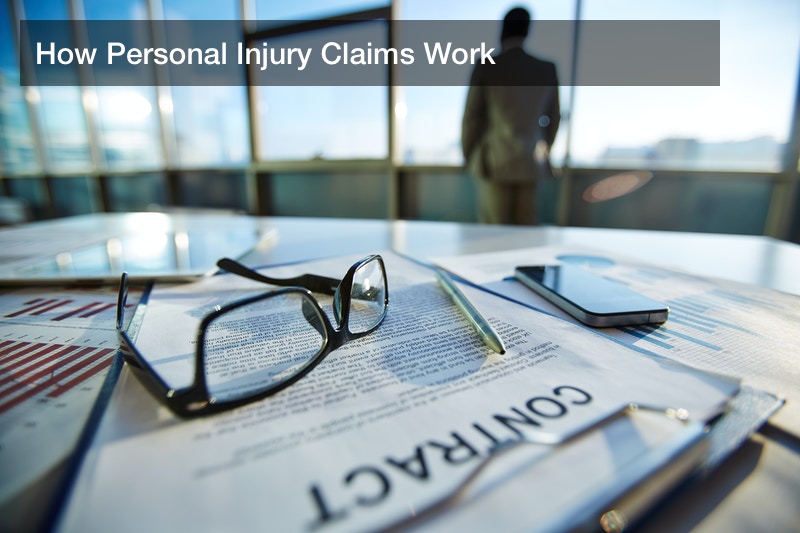
Every year, American roads see about 6 million vehicle accidents. In addition to the millions injured in car accidents, millions more are injured due to falls, medical error, and defective products.
All these incidents have a common thread. When someone is injured due to the fault of another, they are compensated for their out-of-pocket expenses and economic damages through a personal injury claim. However, most people do not know how personal injury claims work. Here are some facts to know about how personal injury claims work and what personal injury attorneys do to resolve them:
Personal Injury Law is Broad
Before explaining how personal injury claims work, it is worthwhile to note that “personal injury law” is not taught in law schools. Rather, lawyers study tort law, which covers all the ways that one person or entity can cause physical or economic injury to another.
Torts fall into three broad categories:
- Intentional torts: Intentional torts occur when someone takes a deliberate action that the person knows will likely harm the other. Some examples of intentional torts include battery, assault, false imprisonment, and defamation.
- Negligent torts: Negligent torts occur when someone breaches a duty to act in a reasonable manner and causes harm to another. The difference between an intentional tort and a negligent tort is the level of knowledge on the part of the wrongdoer. Merely acting carelessly is not enough for an intentional tort, but would be sufficient to establish negligence. Most of the personal injury claims that spring to mind are, at their core, negligence claims. Some examples include vehicle accidents, medical malpractice, and slip-and-fall incidents.
- Strict liability: Strict liability claims are imposed in situations where someone undertakes a responsibility that requires special care. For example, many states impose strict liability for animal attacks and products liability injuries. In a strict liability case, the mindset of the responsible person is not relevant because liability is imposed upon establishing the fact that the person caused the injury.
Personal injury firms might limit their practices to particular types of tort claims. For example, some firms limit their work to vehicle accidents. This is not necessarily because vehicle accidents are subject to different legal principles than slip-and-fall accidents. Rather, this is a business decision based on the knowledge and experience of the firm’s legal staff.
However, how personal injury claims work is essentially the same whether the injury was the result of a dog bite, vehicle accident, bar fight, or medical error. This is because these all fall under the same tort law principles that are used by personal injury lawyers every day.
Work Injuries Are Handled Differently
Keep in mind that although on-the-job injuries are a form of personal injury, work injury lawyers use a different process for resolving claims for injured workers. Thus, the discussion below about how personal injury claims work is analogous to, but not exactly the same as how workers compensation claims work.

This is because 48 states have a compulsory workers compensation structure that requires most employers to obtain either government-issued or private workers compensation insurance. When a worker is injured on the job, the employer is usually required to take the lead in filing the claim and remains involved as the insured.
Once the claim is initiated, the employer’s workers compensation insurer decides whether to pay or deny the claim. If the claim is denied, the worker can hire a work injury lawyer to try to push the insurer into paying workers compensation.
The trade-off offered to employers is that in exchange for requiring them to buy workers compensation insurance, the employers are protected from personal injury claims from their employees. In other words, workers compensation is the sole and exclusive remedy for injured workers in most cases. As a result, most employees will not need to know how personal injury claims work for an on-the-job injury because it is simply not possible to file a personal injury claim for a work injury.
Almost Every Personal Injury Claim Involves an Insurance Company
To understand how personal injury claims work, you must first understand that most personal injury claims involve at least three entities:
- Injured person: The injured person is a claimant and, if a lawsuit is filed, a plaintiff. The claimant is the person trying to get paid for an injury.
- Tortfeasor: The tortfeasor is the person who committed the tort. It could be a doctor who committed a medical error, a manufacturer who made a defective product, or a driver who ran a red light. The tortfeasor is the person whose actions caused the claimant’s damages.
- Insurer: The insurance company for the tortfeasor is usually the entity that is on the hook for the tort. For example, a medical malpractice claim against a doctor will be paid by the doctor’s medical malpractice insurer. Likewise, a vehicle accident claim against a negligent driver will be paid by the driver’s auto insurer. Under the insurance policy, the insurer has a duty to defend the tortfeasor. As a result, a claimant’s injury lawyer will deal primarily with the insurer and the insurer’s lawyer.
In some circumstances, other entities will also be involved. For example, the injured driver’s insurance company may be involved if they paid a claim to the injured person and need to seek reimbursement from the negligent driver’s insurance company. Similarly, an injured person’s health insurance company can seek reimbursement from a negligent person’s insurance company for any medical bills that were paid.
However, for them most part, the three entities that will have the greatest role in how personal injury claims work will be the injured person, the person who caused the injury, and the wrongdoer’s insurance company.
Hiring a Legal Counsel for Your Personal Injury Claim
If you are faced with an injury that was caused by someone else, you should consider talking to at least one lawyer and perhaps speaking to several lawyers for legal counsel so you can discuss how personal injury claims work and what your prospects might be if you pursue one.

Many lawyers offer free consultations. This allows you to interview the lawyer to determine if the lawyer is a good fit for your case. Some of the factors you might consider when hiring a lawyer include:
- Fee structure: Most personal injury lawyers work on a contingency fee basis. This means that instead of being paid out-of-pocket, the lawyer is paid after the case is settled or won. If the case is not won, the lawyer does not charge a fee. Moreover, the lawyer is paid from your settlement or damages award, so you never need to write a check to the lawyer. Instead, the lawyer deducts the contingency fee from the settlement or award.
- Experience: Different lawyers have different experiences. If your case involves medical error, for example, you may want to seek out a lawyer who has handled medical malpractice cases in the past.
- Communication: One of the most important, and most underrated, factors that clients consider is the level and ease of communication with their lawyer. You should choose a lawyer who listens to your story and understands your instructions. Likewise, you should be comfortable talking to your lawyer and understand your lawyer’s advice. You should also expect your lawyer to keep you in the loop by copying you on all communications about your case and providing periodic updates on the progress being made.
How Personal Injury Claims Work Before Filing a Lawsuit
In the initial stages of a personal injury claim, you do not need a personal injury lawyer. However, you may substantially improve your chances of obtaining a favorable outcome if you hire a lawyer. Moreover, having representation early in the case can help you to avoid making any mistakes that might be used by the insurance company against you and your claim.
Specifically, the opposing party’s insurance company is not your friend. The insurance company has a financial interest in paying out as little as possible and, if possible, paying out nothing. To do this, the insurance company will try to shift blame from its insured and onto you for your injury.
The insurance company will use a myriad of other tricks and tactics to reduce its liability and minimize its payout to you including:
- Questioning your injury: An insurance company might claim that you are faking or exaggerating your injury and try to trap you into admitting that you were not injured or were not as injured as you claim.
- Denying causation: The insurer might try to claim or suggest that your injury was pre-existing or was caused by something else, such as a sports mishap, rather than the accident. The insurance company might also suggest that you were somehow responsible for your injuries because you did not seek medical attention or worsened your injury by failing to follow your doctor’s advice.
- Delay: Insurance companies know that you are desperate after being injured in an accident. You will need money to pay for medical treatment and therapy. However, you might be unable to work due to your injuries. Instead of working quickly, insurance companies will use delay to pressure you into accepting a low-ball settlement offer just to stay afloat.
How Personal Injury Claims Work During Settlement Negotiations
After you retain a lawyer, the lawyer becomes the point of contact with the other party’s insurance company. This insulates you from the tricks insurance companies use to deny your claim or reduce your payout. This also guarantees that your settlement negotiations are handled in a professional manner with clear documentation.

Your attorney will usually establish your injuries and damages through copies of medical records, medical bills, property repair bills, pay stubs showing lost wages, and other documents. Based on these records and the insured’s policy, the insurance company will usually deny the claim or make a settlement offer.
Most personal injury claims are settled rather than litigated. This is partly due to the time and expense of litigation and partly due to the unpredictability of jury trials. However, this does not mean that settlement is easy.
The initial offer from the insurance company will likely be below the insurance policy limits and may even be below your documented expenses. Again, the insurance company has a financial interest in paying as little as possible, so it may use your desperation to try to resolve the case quickly and cheaply.
Your lawyer will likely counter-offer, providing arguments about your documented expenses and trying to get the insurance company to increase its offer. This back-and-forth will continue until a settlement is reached or your lawyer concludes that the insurance company is unwilling to make a fair offer.
If the case settles, the insurance company will send a settlement check to your accident attorney. The attorney will deduct the contingency fee from the settlement check and send you the remainder. Contingency fees are usually a percentage of the settlement or damages award. This guarantees that you will receive something from the case. For example, a lawyer might charge a 30% contingency fee, meaning that you will receive 70% of the settlement check minus agreed upon expenses, if any.
How Personal Injury Claims Work if a Lawsuit is Filed
A lawsuit might be necessary if the case cannot be settled. The lawsuit would name the person responsible for your injuries, but the insurance company would remain involved because it has a duty to defend its insured. Moreover, any damages award would be paid by the insurance company, so it has an interest in remaining involved.

Lawsuits can be used to keep a case moving forward. Whereas settlement negotiations can drag on and on, lawsuits are controlled by a scheduling order from the judge assigned to your case. This order sets out all the deadlines in the case and limits the ability of the insurance company to use delaying tactics.
The parties to the litigation will exchange documents and may give testimony in depositions. This evidence is used to help the lawyers develop a theory of the case, which sets out the facts of the incident and their legal relevance. For example, in a slip and fall injury claim, some relevant facts would include how long the property owner or manager knew of a spill and whether any actions were taken to either warn customers or clean up the spill.
If the case goes to trial, the evidence is presented to a jury. Evidence can include documents, such as x-rays of the injury, witness testimony, such as a statement from the store manager who saw the fall, and expert testimony, such as a doctor offering an opinion about how long the injury will take to heal.
At the end of the trial, the jury will deliberate by weighing the evidence and applying the law to it. If the jury finds liability for the injury, the jury will also determine the damages you are entitled to. Thus, a jury could find in your favor but only award you half of your expenses if it finds that you were half at fault for your injuries.
Personal injury claims are relatively straightforward legal claims. Many personal injury lawyers develop a process for handling these cases in an orderly way by contacting the other person’s insurance company, attempting to negotiate a settlement, and, if no settlement can be reached, litigating your case before a jury.




